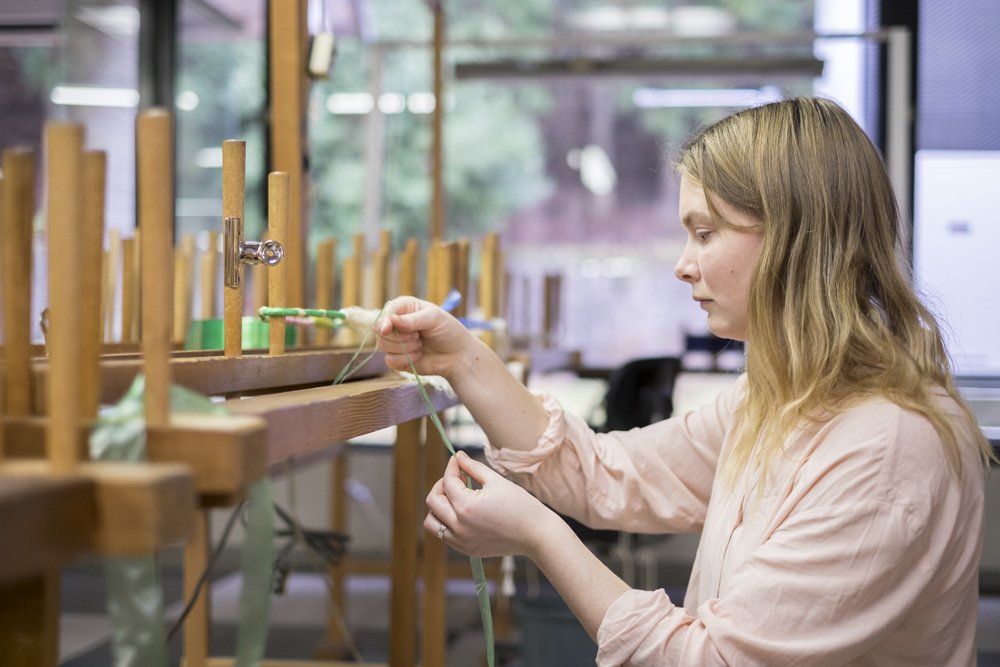(part 1 here)
Kawashima Textile School, an amazing one-kind school.
In June, I visited the Kawashima Industry Museum. I was marveled with the quality and the persistence to achieve perfection on textiles.
Three months ago I had come to Japan and I already had had an approach to Japanese traditional crafts, but seeing a place in the industrial process which had maintained high quality standards was impressive!
Indeed, Japanese people have genes for liking textile's excellence.
In this visit, I discovered that Kawashima Company has a Textile School. My wish to attend to this school came true with the support of Kyoto Institute of Technology.
Between August to September, I had the opportunity to attend the Chuya Ori Workshop with Keiko Yoshida Sensei; the Natural Dye Workshop with Masaru Hori Sensei; and finally, the Nassen Gasuri Workshop with Kozue Yamamoto Sensei.
In the Chuya Ori Workshop I learnt the importance of small details. For example, tying a proper knot is an action that usually goes unnoticed, but is very important. Keiko Yoshida helped me a lot to introduce me to the school and teachers with her fluent English.
With Hori-Sensei, I discovered the beautiful natural dyeing colors that the Japanese people have produced for centuries. Hori-Sensei's dyeing technique with two rods or metal 'hashi" was new for me.
As a Spanish speaker this was the most difficult class, because of its many vocabularies in Japanese. But Hori-Sensei and my team encouraged me in doing the exercises and supported me with the translation of concepts in English.
Yamamoto Sensei's Workshop was interesting. It was my first time I dyed on the loom with the stencil technique. This course taught me the importance of concentration and to know your own rhythm for working.
In these three workshops, the teachers and students showed me a part of Japanese culture: the significance of small details, the importance teamwork, to be patience and perseverant to achieve your own goals.
Kawashima Textile School is different from others. It doesn’t matter how old are you or what your profession is, only if you are really interested in learning about textiles.
Not only the workshops are high quality programs, all the teachers and people that I met in KTS were high qualified. I’m so grateful with their advise, otherwise I couldn’t have approached other textile artists, artisans and designers to complete my JICA's research.
Thank you so much to KTS for everything! I hope the School continues supporting textile lovers!
December 1, 2011
Ivonne Sigler part 1
Hi, my name is Ivonne Sigler. I’m a young textile designer in Mexico.
At the beginning of this year, I traveled to Japan because I made a training course in “Modern Design and Traditional Culture & Craftsmanship” held by the Japan International Cooperation Agency (JICA).
This eight-month’s training course consisted in two parts. The first period was formed of master course’s classes in Kyoto Institute of Technology; related on Japanese traditional culture and aesthetics.
For example, I attended lectures given by Mr. Kitayama the gardener of Kodaiji's Temple; by Mr. Keimei a famous Buddha Sculptor; and by Mr. Morito an Architectural decorator. I also visited Watabun Company (brocades from Nishijin), Zuikogama Company (Ceramics), Shoeidou Company (Incense), and others. This was my first deep approach to Japanese traditional culture trough their artists and artisans.
The second part of the program began on September. It consisted in making my personal project. Because I am a textile designer I decided to research about traditional weaving and dyeing techniques, as well as interviewing textile and fashion designers: to learn how they apply the traditional techniques in the contemporary clothes or interior design.
My research consisted of eight interviews, eight weaving and dyeing workshops, stays in other cities, like: Tokyo, Okinawa and Nagoya; and visits to remarkable temples or buildings, museum’s exhibitions and design stores.
The design process that I learnt in Japan was unexpected. The Japanese Design is so close to philosophy and also to humans. I could notice a strong relationship with human’s fundamental problems, such as those connected with existence, knowledge, values, reason and language.
As designers we are focus on the aesthetic or the functional of the product for follow the market constants demands. But when we rediscover the past techniques and we stay in contact with the artisan's work, we remind the importance of pursuing bring a better service to humankind using wisely the natural resources and knowledge.
The designer’s main goal should be to build a bridge between these artisans and the common people. Always reminding that before products are the human beings.
Above all, we have to preserve things that remind us of our humanity.
Subscribe to:
Posts (Atom)






